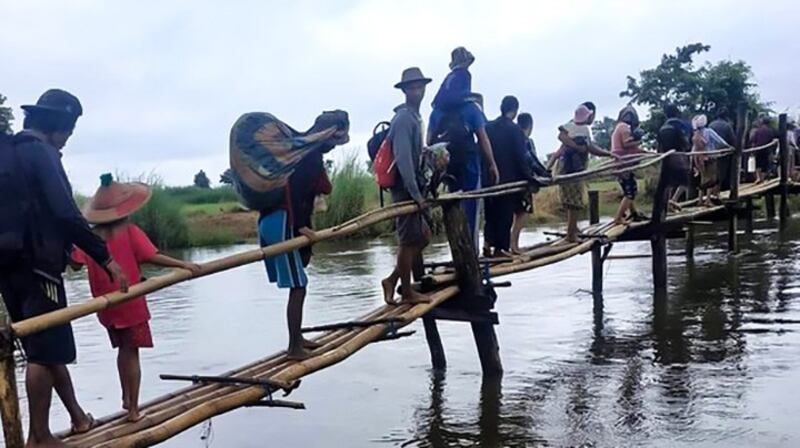Nearly 3 million people have fled Myanmar because of armed conflict, nearly half of whom left the country after last year’s military coup, an independent research group said Friday.
The Myanmar Institute for Strategic and Policy Studies (ISP-Myanmar) said 2,930,201 internally displaced persons (IDPs), or slightly more than 5% of Myanmar’s population of 54.4 million, have fled violence in the country. It said 1,413,811 of them, or 48%, fled Myanmar amid the conflict that followed the Feb. 1, 2021, putsch.
According to ISP-Myanmar, the number of people in Myanmar who were classified as IDPs due to civil war more than doubled to 1,019,190 after the coup from 497,200 prior to the takeover.
The research group said its list was compiled from data obtained by organizations that assist refugees in conflict zones, international aid groups, ethnic armed groups, and reporting by independent media. It said the data had been checked and confirmed by its researchers.
ISP-Myanmar senior research officer Kyaw Htet Aung told RFA Burmese that all combatants in Myanmar must adopt measures to reduce civilian suffering.
“IDPs do not have full access to humanitarian aid at present and their number is rising month by month,” he said.
“How are we going to solve the problem? All the adversaries must pay more attention to military codes of conduct to minimize harm to civilians. If they can do that, I think civilian suffering would be substantially reduced. Additionally, IDPs must have better access to international aid.”
According to ISP-Myanmar, 533,833 people displaced by violence since the coup are from Sagaing region, where the military has encountered some of the fiercest resistance to its rule over the past 19 months.
Aid workers told RFA that fighting between the military and the armed opposition is intensifying and spreading rapidly throughout Myanmar, resulting in a substantial increase in the number of IDPs and civilian casualties.

No access to international aid
A villager who recently fled fighting in Sagaing’s Kanbalu township said that IDPs have had to rely on assistance from people in the region because they have not received any international aid.
“We have been on the run since the moment the military entered our villages, and we’ve faced a lot of difficulties moving through the jungle with the elderly, pregnant women and children,” he said, speaking on condition of anonymity.
“People are exhausted from running and hiding for so long without food. These days, it's difficult to get even one or two baskets of rice. We have never received any international aid. We all are struggling to stay alive.”
In addition to the challenges of obtaining food and medicine, the villager said his group also faces dangers such as snake bites while sheltering in the jungle.
Similar problems have been reported in Chin state, where transportation is difficult due to the region’s terrain and lack of infrastructure.
An official with the Mindat Township Refugee Camps Management Committee, who declined to be named, told RFA that basic food items and fuel are getting expensive, leaving IDPs in dire straits.
“The price of rice has risen and with the increase in fuel prices, buying rice has become even more difficult,” he said.
“In the meantime, we are also facing the danger of landslides because it is the rainy season. There are a lot of landslides here as it has been raining non-stop for more than two weeks.”
Banya, the director of the ethnic Karenni Human Rights Group, said IDPs also endure psychological suffering when they lack food, shelter and healthcare.
“The loss of their family members and homes, and being in the jungle for a long time, leaves them stressed,” he said.
“When they go from expecting a month or two of displacement, to six months, and finally more than a year, it’s very difficult to comfort them. Their losses are heavy and it is a difficult situation to bear. Currently, everything — including health conditions — have been quite bad.”
At present, he said, only emergency measures for obtaining food and medicine can be offered to the displaced, while long-term planning has been out of the question.
Aid program status unclear
Win Myat Aye, minister of Humanitarian Affairs and Disaster Management for the shadow National Unity Government (NUG), said efforts are underway to provide aid to the country’s IDPs, but he acknowledged the limitations he faces.
“With more than a year and a half of experience, our connection with aid groups has gradually become stronger and we can now provide more effective support,” he said.
“Access to funding and cash flow is a challenge, but now that the NUG has its own sources of income, it can supplement public donations. We are making special efforts in cooperation with ethnic armed groups to provide international support.”
He said he believes humanitarian assistance will soon be able to reach the displaced.
At the Association of Southeast Asian Nations (ASEAN) Humanitarian Assistance Coordination Meeting held in Phnom Penh, Cambodia, on May 6, a decision was reached that the ASEAN Humanitarian Coordination Center (AHA) would act under the supervision of Myanmar military authorities to provide aid to the country’s IDPs.
On Sept. 20 pro-junta media reported that the AHA task force held an interim meeting on the aid situation in Myanmar, but more than four months since the ASEAN decision, RFA has been unable to independently confirm the status of the program.
Attempts by RFA to contact the AHA Center went unanswered on Friday.
According to Thailand’s Assistance Association for Political Prisoners (Burma), authorities in Myanmar have killed at least 2,316 civilians and arrested more than 15,600 since the coup, mostly during peaceful anti-junta protests.
Translated by Khin Maung Nyane. Written in English by Joshua Lipes.
